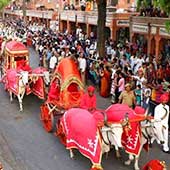Design Resource
Gangaur Festival of Rajasthan
Infographic Timeline of Festival
by
Introduction
Gangaur is one of the most awaited and vibrant festivals for the women of Rajasthan. It is celebrated with great fervour and enthusiasm over the state. It is a huge local festival for both married women and young maidens to celebrate the harvest, spring, marital harmony and childbearing.
Gangaur procession in the city bazaar of Jaipur. (Image source)Throughout Rajasthan and many other states in India, the divine marital bond of Shiva and Parvati is worshipped during Gangaur.
Goddess Parvati is regarded as the epitome of marital love, courage, strength, power and excellence. Thus, during Gangaur, Parvati is worshipped for the wellbeing, long life, health and wealth of their husbands and marriage, by the married women while young maidens pray for getting a smart, understanding, suitable life partner and future marital prosperity.
Significance
The word Gangaur is made up of two words, “Gana” or “Gan” is the synonym for Lord Shiva and “Gaur” which stands for Gauri or Parvati. They’re considered an ideal couple and Gangaur worship symbolize “Saubhagya” or marital bliss.
A divine couple of Lord Shiva and Parvati. (Image source)Married and unmarried girls worship Gangaur every day of the festival with Durva grass, Kalash filled with clean and fresh water, flowers and fruits and observe fast seeking for a blessing on this auspicious event. “Gauri” also means “Yellow” emblematic of the ripened harvest.
Ramcharit Manas describes Sita’s visit to the shrine of Girija or Gauri early in the morning, accompanied by her lovely companions and attendants who are singing joyous songs. After ablutions, Sita approaches the goddess with a cheerful heart and a contemplative mind, and after devoted adoration, she prays to Gauri for a handsome and a perfectly matching bridegroom. And finally, her wish is fulfilled when Rama wins her hand in marriage. [1]
Thus, Gangaur puja symbolizes the marital bond of Lord Shiva and Parvati. Her austere dedication and meditation helped her win Shiva’s heart. It is said that during Gangaur, Gauri came back to her parental home to evoke marital bliss.
History
The term “Shakti” has always held a special status in the Hindu religion. Shakti refers to an exclusively feminine principle and is perceived in all phenomena of life. The originator of life on Earth, it is responsible for the movement of all things, be it the cosmic objects or the various forces of nature. Deprived of Shakti, all creation on the planet will be rendered inept. Numerous ancient Indian texts, like the Vedas, Puranas and Epics bear citation of this cosmic power, recognizing its godly form as Parvati, the wife of Hindu God, Shiva. Over the ages, Shakti has been synonymous to a myriad of forms and identified under many names, one of which is Gauri. And as is suggestive by the name, the notable Gangaur festival is observed in honour of this very manifestation of Shakti (Gauri). [2]
Parvati, the wife of Shiva. (Image source)The Shiva Parvati folk stories read during Gangaur revolve around basic human tendencies while Shiva and Parvati are diving powers capable enough to change the course of events. In these stories, Shiva is depicted as handsome but not well-groomed or dressed but mature, patient, sensible and far-sighted person, while his wife Parvati is portrayed as being an extremely beautiful but very impulsive, impatient and impractical person. While they contrast in their personalities, both of them are extremely loyal and romantic.
Timeline
The festival starts from the first day of Chaitra (March-April) which is the first month of the Hindu Calendar and continues for a total of 18 days culminating on Gangaur Pooja on “Chaitra Shukla Tritiya” i.e. the third day after the full moon. It falls right on the next day of Holi which is celebrated on the last of the Hindu lunisolar calendar month. Thus, it also marks the end of the winter season and the coming of spring and harvest with its onset.
Hindu calendar months timeline. (Image source)Overall timeline






